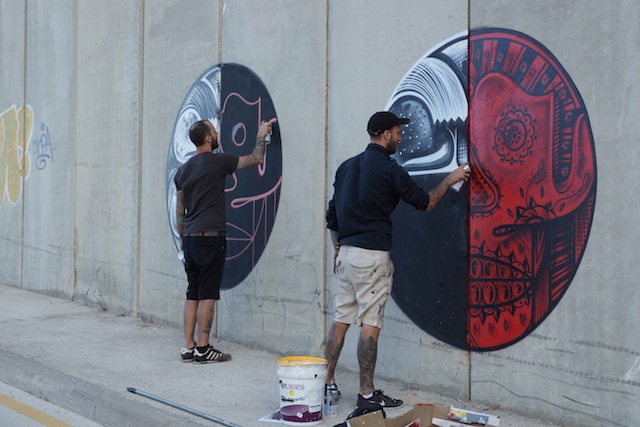
Today we have a guest post from William Parry about How&Nosm’s recent trip to Palestine to work with the charity Medical Aid for Palestinians. Parry is the communications officer at Medical Aid for Palestinians and it’s certainly a bit atypical for a communications officer to write a guest post for Vandalog about a project they are in charge of, but Parry is also the author of Against the Wall: the art of resistance in Palestine (2010), which was reviewed on Vandalog a while back, so he’s also uniquely qualified to write about graffiti writers and street artists working with Palestinians and painting on or near the separation wall. I also had to privilege of seeing Parry speak at Haverford College last year, and it’s clear that improving the lives of Palestinians is his passion as well as his job. Also, if you want to read more about How&Nosm’s time in Palestine, Brooklyn Street Art also have a great post about the experience. – RJ
Sometimes you take a chance and it pays sweetly. Bringing How&Nosm to Palestine over the past two weeks was one of them, and I believe they feel the same, as they also didn’t know exactly what they were setting themselves up for.
Almost a year ago, I first met the Perré twins, Raoul and Davide, while doing an article about Prague’s ‘Stuck on the City’ street art exhibition. We got talking about politics and the Palestinian-Israeli conflict, and I eventually asked whether they would ever consider collaborating with the UK-based charity I had just begun working for, Medical Aid for Palestinians (MAP), doing art workshops with MAP’s local partners in Palestine. “Sure,” they said. It would give them a chance to also do their own artwork on walls around Palestine.
A year on and countless emails later, I was anxiously waiting for them at the airport in Tel Aviv, wondering if the Immigration officials had caught wind of the project and would send them back to NYC. The heavily tattooed, stencil-and-cap-carrying twins said they were here for a 10-day organized tour. Nosm appeared after some time and said his brother had got stopped. “They didn’t believe we were here for the tour and asked us who else was on it,” he said. “How should I know, I told them, maybe just us for all I know! What could he do?” Another 10 minutes went by before How walked through the sliding doors, straight-faced, then he cracked a smile. “They went through my photos on my camera, asked why I was here of all places. I said: ‘I’ve been to 60 countries but not here yet. I want to tick Israel off the list.’”
Within minutes we were in the car for central Tel Aviv to get them a pre-order of cans in their signature colours. Three young guys running the shop were clearly honoured to have How&Nosm on their turf and volunteered to guide them to the best places to bomb. “What have you got planned?” one asked. “We’re here for some work,” said Nosm, keeping schtum. They clearly wanted to paint with them but Nosm took their numbers and said they’d be in touch. We filled the trunk with boxes of spray cans and headed for occupied Palestine.
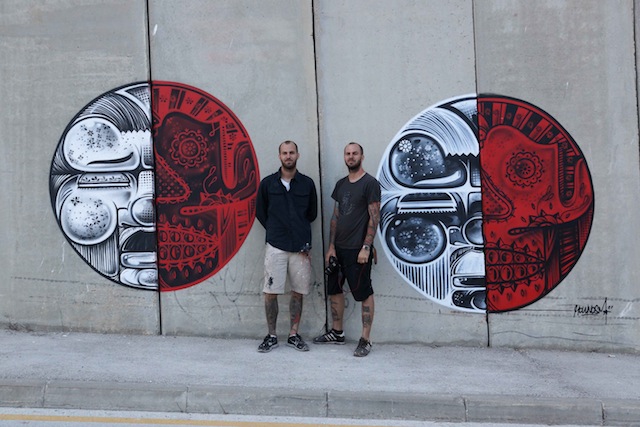
Their natural environment is the street so I shouldn’t have been surprised that How&Nosm were keen to check into their East Jerusalem hotel, grab a quick shower and then head immediately to Bethlehem to sort out more paint, rollers, ladders and walls to paint – despite having travelled for about 20 hours by this time. We met a Palestinian street artist who goes by the name ‘Trash’ – he worked with Banksy to sort out his 2007 Santa’s Ghetto project in Bethlehem, and has also helped JR with several local projects. As dusk fell, Trash gave them a quick tour of ideal spots to do murals and arranged to meet the twins the following morning.
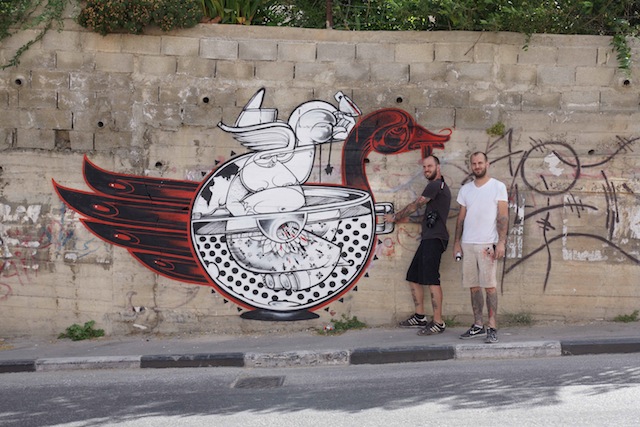
Over the next two days they produced three murals around Bethlehem – the largest ‘Lost Conversation’, as well as ‘In Mother’s Hands’ and ‘While Drinking Tea’ – and one in East Jerusalem, ‘Split Identities’. Locals would stop and talk to them, as usual, asking where they’re from, why they’re here, what the intricate images mean. But with four murals done, it was down to other serious business.
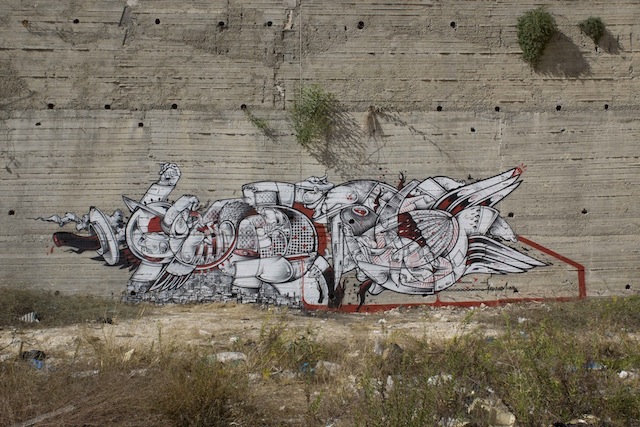
What How&Nosm witnessed for themselves as we drove through the occupied West Bank – scores of illegal Israeli outposts and settlements built on Palestinian land, the scandalous route of Israel’s illegal separation wall, seeing the freedoms that Israelis enjoy at the expense of Palestinians’ human rights, and hearing of Palestinian homes being demolished or taken over by Israeli settlers, shocked them deeply. They spent one day with a former Israeli military commander, Yehuda Shaul, who co-founded an Israeli human rights organization called ‘Breaking the Silence’. He drove them to the southern point of the West Bank and, throughout the journey, gave them a clear understanding of the layers of Israeli occupation and their intended impact on Palestinian communities – ethnic cleansing. I spent many days in the car with How&Nosm, talking about the situation among other things, and you could see their frustration and outrage growing with every mile covered as the occupation unfolded before their eyes.
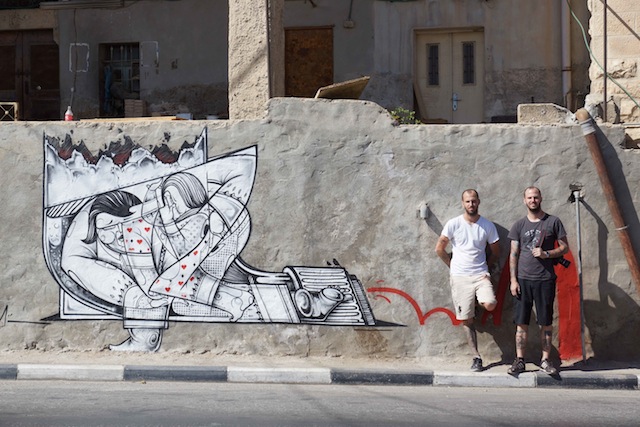
“We weren’t prepared for the depth of discrimination we’ve seen against the Palestinians. The Israelis make rules against virtually everything that makes life possible – accessing water, farming land, building homes, getting to hospitals. They just want to get rid of the Palestinians and take their land. It’s merciless,” said Nosm.
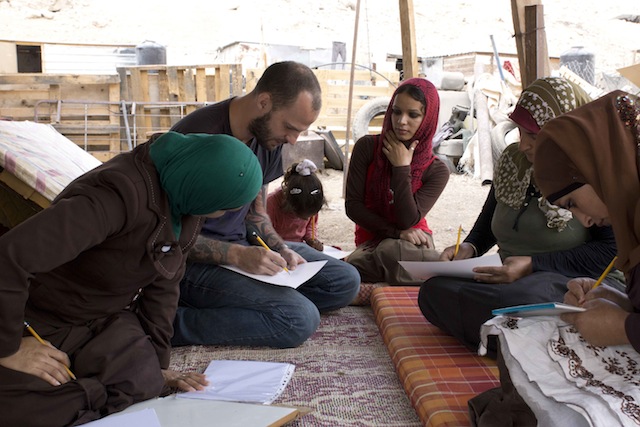
They conducted workshops with two different groups – Bedouin women from an impoverished, make-shift encampment in the desolate Jordan Valley, just outside of Jerusalem, and kids at an after school educational organization, the Saraya Center, in Jerusalem’s Old City. Over four days How&Nosm taught the women and kids everything from basic drawing skills to creating stencils, to creating colours with paints to a crash course in spray painting.
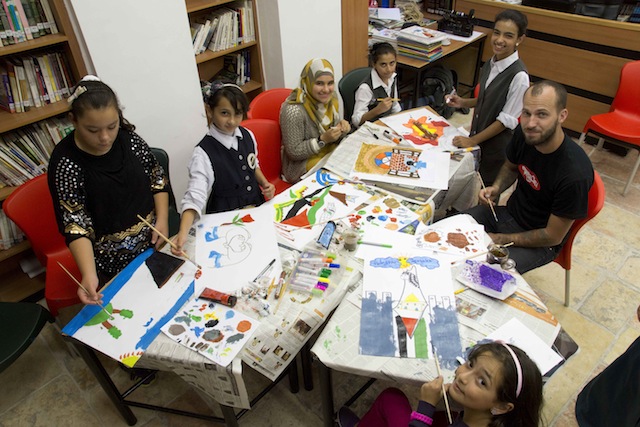
“We weren’t sure what to expect when we drove into the Bedouin encampment – when we saw the condition of the camp, we were shocked. These aren’t villages, these are slums, and the people aren’t given an opportunity to lead normal lives because of Israel’s occupation. So we thought, ‘We’re going to have a lot of ice to break with these women.’ But their enthusiasm was immediate, which was really cool,” said How. “Also,” he added, “it’s quite surreal, bringing this modern day, urban society tool – the spray can – to this context and seeing it used in a very different way of self-expression to what we’re used to.”
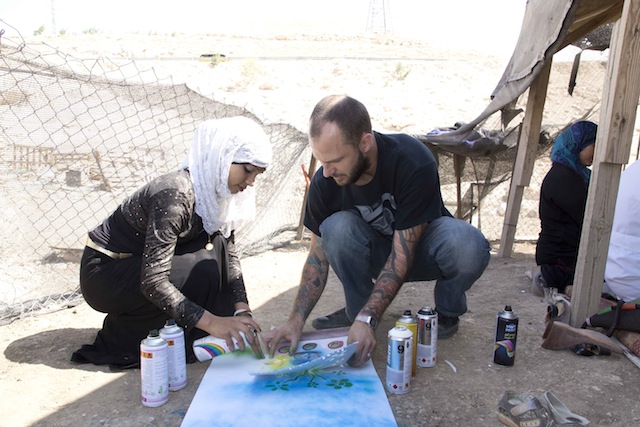
While the twins offered their hip art know-how, they learned a lot about Palestinian identity and symbols from the participants – the iconic Dome of the Rock mosque, with its glittering dome, stunning blue walls and elaborate Quranic calligraphy; olive trees, as a symbol of what has sustained Palestinians for countless generations and the bounty of the land; keys, signifying the forced displacement of now millions of Palestinian refugees denied their right of return after over 65 years, who took their keys with them in 1948, thinking they’d be home after a few weeks when the fighting settled down; and the cruel separation wall that has annexed another 10% of Palestinian land illegally.
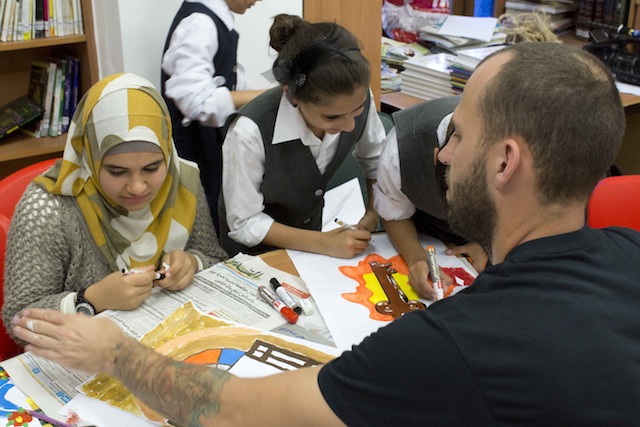
“I didn’t know the meaning of the keys, but it reminded me of a key that we designed,” said How.
With that in mind, following the second workshop, the twins went back to Bethlehem with their spray cans and adapted their key to the local context. As dusk turned to darkness, they quickly painted a key on a large metal military gate in the wall by Rachel’s Tomb in Bethlehem, in the area of Aida refugee camp – an area graced by Ron English, Sam3 and Erica il Cane over five years ago. After a half hour, soldiers yelled in Hebrew from a tower, presumably asking what they were doing.
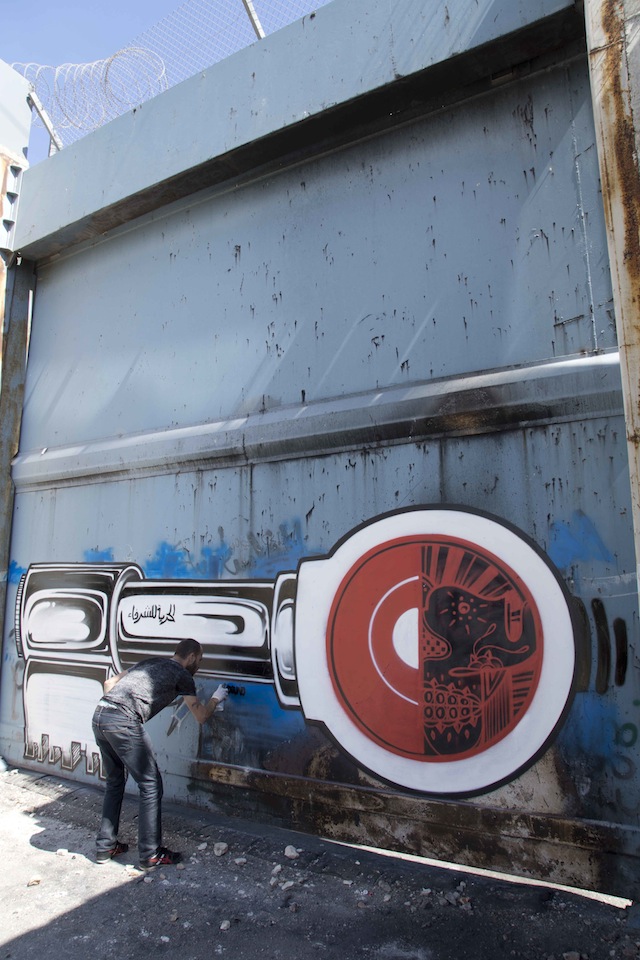
“Speak English?”
“What are you doing?”
“We’re from New York, we paint,” Nosm shouted, and they continued. Moments later the gate rolled to the side and four soldiers rushed out, with the commander shouting, “What are you doing here?”
“We’re painting,” they replied matter-of-factly.
“It’s illegal,” he shouted back. “I’ll have to arrest you.”
“Arrest us?! For painting? We’re American, you gonna arrest Americans? We pay for this wall.”
“It’s illegal,” he replied, flustered by their disregard. “It’s for security.”
Pointing to all of the art and graffiti on it, How asked: “If it’s illegal, and you’re here for security, why is there all of that painted on it? You guys been sleeping up there or something?”
I added: “This wall is illegal. So it’s illegal to paint on an illegal wall? Where’s the logic in that?”
This charade went on for a half hour, with the soldiers relying on their weapons and threats of arrest to win the debate, so we said it was pointless carrying on and walked to the car. In the car, the twins were excited about returning to finish it. “The key is about the right of return for Palestinians,” said How, “and we will also return – to finish it!”
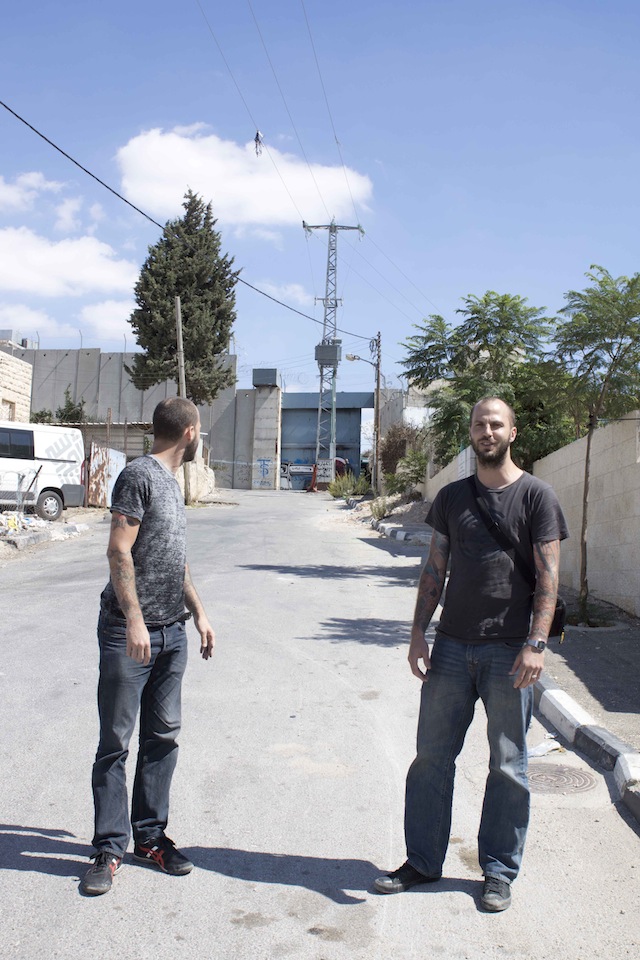
The following day, the twins were back. They came with a stencil in Arabic script that the Bedouin women had made that morning, which said: “Freedom for the honorable”. They quietly approached the gate and began finishing the piece. Just as How was adding their tag, the gate quickly rolled open. They promptly turned and walked downhill towards Aida camp. The soldier shouted something, presumably to stop and come back. They kept coolly walking away. One of the soldiers picked up the abandoned spray can and went over the Arabic text and defaced the piece – “The occupation will prevail” he wrote in Arabic. Stars of David were also spray painted over the piece.
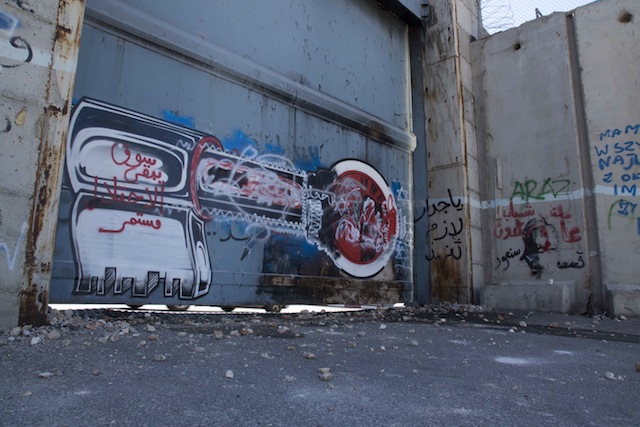
“That’s twice the key opened that gate! See how sensitive they are to a picture of a key and what it represents?” How shouted as we drove off. “Did you get a picture of it completed?” Nosm asked? “That’s what counts. We’ve had loads of shit defaced but if you get a photo of it completed, that’s going round the world and there ain’t nothing they can do to stop that!”
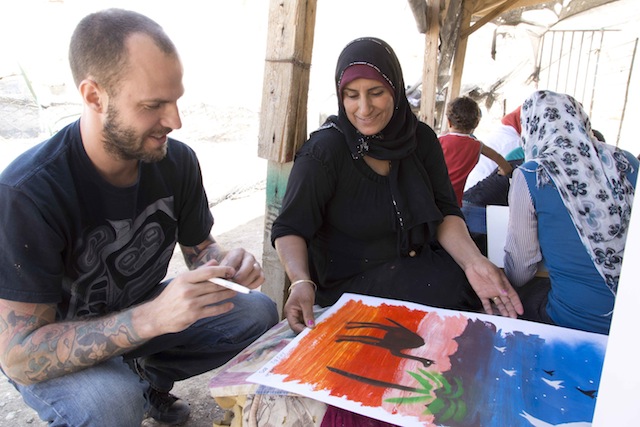
The workshops concluded after four days and were a unique success. For the Bedouin women, the workshops had a constant air of fun, creativity, chatter and laughter. “You came with respect and humanity, and we felt that,” said Maesi’, one of the participants. For the kids at the Saraya Center, they worked with the twins to produce a collage of artwork, mounted on foam board. One of the girls, Aiya, was asked on video what she liked about the workshop. “Through their way of teaching, Raoul and Davide gave me the confidence that I could do it. They inspired us to do things we didn’t think we could do.” She paused, put on a brave face and walked away and, moments later, began sobbing. Within seconds, several other girls were doing the same, moved by the emotion, knowledge, fun and skills that How&Nosm brought to their world from NYC.
“We better go before we start,” said Nosm, and they said goodbye.
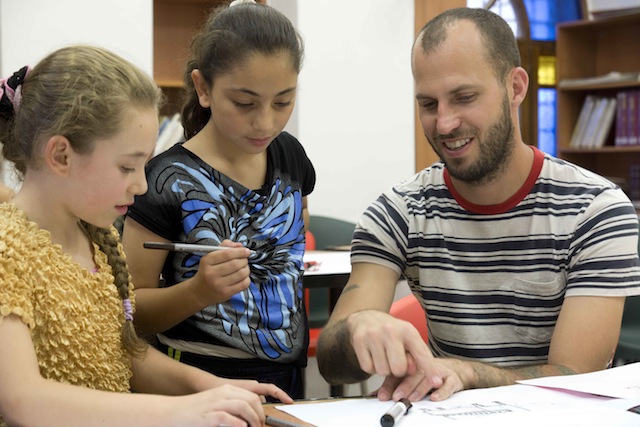
Outside of their workshops with MAP, How&Nosm infused their murals with local themes and symbols that they picked up from the trip. ‘More is not enough’ speaks of Israel’s relentless colonization of Palestine, as does ‘Piranha’, both in Bethlehem. On their last day they used up their remaining paint to do a mural in Beit Sahour, entitled ‘1948’ – the year that the majority of Palestinians were forcibly displaced from their homes by Jewish militias, and who wait, with their descendants, in limbo as refugees for their UN-sanctioned right of return to their homes.
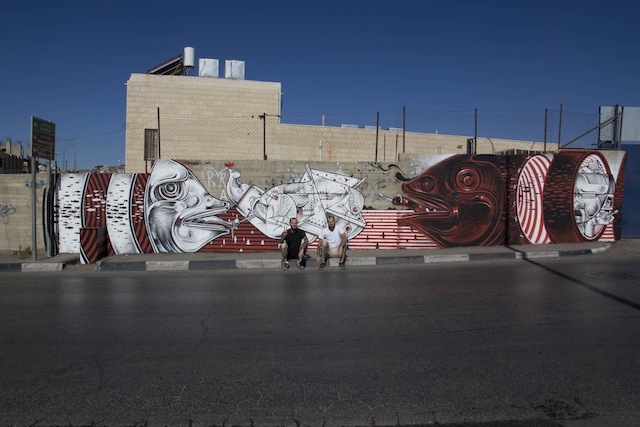
Before they started ‘1948’ we sat in the garden of the family that owns the wall where the mural is now. They stressed the importance of coming to Palestine and Israel to see the reality with one’s own, open eyes.
“It was important for us to see first hand what is going on in the conflict rather than just reading about it,” said Davide. “Even in the independent media you don’t get the full picture, it’s just not the same experience as coming and seeing the illegal outposts and settlements and other things that exist, and I think we have a better understanding of that, thanks to MAP.”

“There are too many war crimes being committed [here],” Raoul added. “The wall, the settlements, the cutting down of olive trees, the racism that Palestinians face… All that plus [the Israelis] hide it so well to the outside world and nobody realizes how many issues there are and not just the one thing that Palestinians ‘terrorize the Israelis’ and that’s where there’s a ‘security’ wall. I think the lie that is spread is pretty much the worst thing there is, and that’s why there’s no support for the Palestinians.”
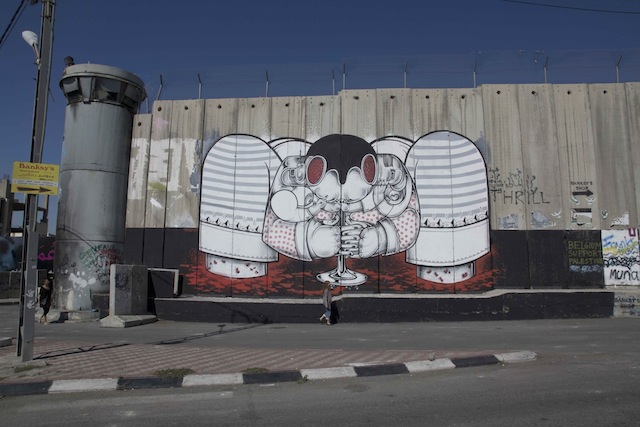
Leaving Israel is usually much trickier than entering, with airport security often isolating travelers to ask them about whether they travelled into Palestine, why and who they dealt with, followed by a strip search. I emailed the twins to ask how it went and whether they arrived home fine.
“Yes,” said Nosm, no problems, adding: “Thank you for this great opportunity. It was a life changing trip and mind blowing.”
Like I said: sometimes you take a chance and it pays sweetly.
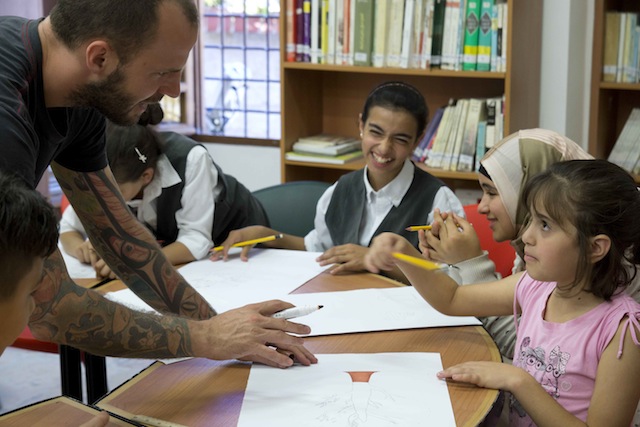
Photos by William Parry
